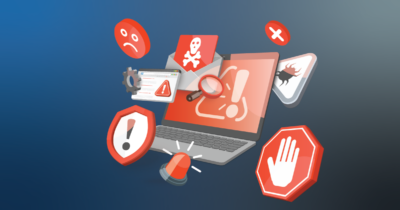Blog
The Human Side of Automation: Building a Culture of Empowerment
In the age of digital transformation, where technology reigns supreme and automation is the buzzword of the day, it's easy...
From Reaction to Action: Accelerating Incident Response through Automation
In the Digital Age, IT incidents are an unavoidable aspect of business operations. From hardware failures to security...
The AIOPs and Automation Handshake: Managing the Modern IT Stack
To increase business agility, IT organizations are deploying dynamic, modern architectures enabled by virtualization...
What Is Intelligent IT Automation (and How Do I Get Started)?
So, you’ve been tasked with automating one or more of your tedious, time-consuming IT processes… but, what exactly does...
Building a Persuasive Business Case for Automation: A Comprehensive Guide
In today's increasingly complex and rapidly evolving business landscape, the integration of automation technologies has...
Automation Amusement: A Lighthearted Look at the Trials and Tribulations
Automation adoption can sometimes feel like trying to teach a goldfish to tap dance – a bit daunting and a whole lot of...
New & Exciting Announcement: Resolve Automation-as-a-Service is Now Available to All
We are thrilled to share with you an exciting development in the world of automation: Resolve Automation as-a-Service...
Doing Nothing Is a Choice – A Very Expensive One
In the fast-paced world of IT, where technologies evolve at lightning speed and the demands on systems and infrastructure...
Implementing Automation: Top 5 Mistakes to Avoid
Automation has become more than just a “nice to have” choice. It’s an essential part of the modern business landscape,...
RAN: The Unsung Heroes of the Telco World
Radio Access Network (RAN) – it's not just an acronym, it's the backbone of your mobile experience. Ever wondered how your...
Top Barriers to Automation: Turning Challenges into Opportunities
In today's rapidly-evolving business landscape, automation has become an essential tool for organizations looking to...
The Financial Services Automation Toolkit for Orchestrating Existing Automations with ITPA
The spike in pressure among the financial services industry is one that today’s organizations have to get in front of. When...
Q&A: What IT Automation Best Practices Should You Know Right Now? – Part 2
Editor’s Note: This blog follows Part 1 of a two-part series that recaps our first-ever “Ask Me Anything (AMA)” webinar....
Q&A: IT Automation Best Practices for 2024, Part One
Editor’s Note: This blog is the first of a two-part series that recaps our first-ever “Ask Me Anything (AMA)” session. Part...
Modernizing Financial Services with Automated, Proactive Threat Management
There’s a rising and intensifying pressure on financial services institutions that aligns with the demand for...
‘Tis the Season for Automation as Retail Sales Pump Problems in IT Systems
December: The month that breaks the internet Every. Single. Year. An exponential increase in sales likely tops...
Automation, AI: Modernizing Financial Services in a Future-focused World
IT automation delivers plenty of excitement for the financial services industry, with its power to make AI even more...
IT Automation Powers SRE Practices as System Complexity, Consumer Demands Grow
Site Reliability Engineers (SREs) use automation and orchestration capabilities to scale security and performance, ensuring...
Digital Disruption in Financial Services: Getting Ahead with Automation
The state of financial services today spotlights core banking digitization and the bigger-than-life disruption it’s causing...
Top 5 Financial Services Trends IT Leaders Must Know to Accelerate Digital Transformation
We could probably sum up the direction the financial services industry is headed in just two words: digital transformation....
Resolve Systems Recognized as a Representative Vendor in the 2023 Gartner® Market Guide for Network Automation Platforms
Gartner®, in its latest Market Guide for Network Automation Platforms released November 2023, followed the company’s track...
4 Reasons Why NOCs Need Incident Response Automation
Incident response in a Network Operations Center (NOC) is cumbersome and time-consuming. There are many steps, many sources...
4 Important IT Automations Explained for Success in 2024
It’s safe to assume that planning ahead is everything to business leaders right now, as the start of 2024 is right around...
AppDynamics Talks Optimized Self-healing with Full-stack Observability, Auto-remediation
From an IT perspective, technologists generally agree that the ability to monitor and have visibility into the IT stack...
4 IT Automations For 2024: Essential Strategies and Tools For Success
Wouldn’t it be great to have a playbook that helps you prepare for 2024 and as a bonus, thrive during the coming...
NOC Success Like Never Before: Automation Strategies for All-new Incident Management
Network Operations might never be the same. But then again, why would anyone want it to be? The power of...
Service Blueprinting and Orchestration for Elevated Customer Experiences
Chances are, you’re familiar with the strategy of adding an additional “9” to service level agreements (SLAs) to boost the...
Automation Cheat Sheet: How Telco Leaders Ace the Test of Driving Process Efficiency
Telecommunication (Telco) companies everywhere share a similar vision: future-proofing their organizations for an...
The Path to a Dark NOC: Actionable Initiatives to Achieve Full Autonomy
A Dark Network Operations Center (NOC) is one that runs with no IT staff … at least that’s how it’s been defined up until...
Faster, Stronger, Better: How Top Telcos Map Innovative Actions to Real Results
The telecommunications industry today is focused on delivering advanced, reliable connectivity and the highest possible...
Accelerated Remediations: How to Maximize AIOps Investments in Network Operations
So, you’ve spent some money and you’re the proud owner of a shiny new AIOps tool that helps improve your Network...
Telco Operations: More Powerful and Efficient, One IT Automation at a Time
Technological advancements in telecommunications are keeping everyone on their toes, as communication service providers...
Joining the Power of AI and Automation: Today’s Business-critical Opportunity
Artificial intelligence (AI) won’t fade anytime soon, and since Generative AI (genAI) joined the party in Nov. 2022,...
Starting the XLA Journey: A Next-level Perspective for Enhanced Experiences
There’s a profound shift happening today that is taking businesses in a fresh, new direction. Outcomes are at...
Navigating IT Transformation with Automation: Your Two-pronged Strategy to Future-proof IT
Daunting. It’s one of the first words that comes to mind for IT and business leaders tackling the challenges of 2023 and...
4 ITSM Automation Moves to Boost Business Growth Through Change
The life of an L1 engineer … receiving all the tickets, providing all the IT services, and interacting with all the...
Automation, Rain or Shine: A Fortune 500 Network Communications Enterprise’s Story of Enhanced Alarm Management
A leading provider of advanced network communications and technology solutions for consumers, small businesses, enterprise...
Resolve Automation Capabilities Framework: From Tactical to Strategic End-to-end Automation
All business eyes seem to be focused on the current challenges of an unsteady economic environment, and organizational...
Automation to Take Airlines to High Altitudes During Unexpected Challenges
President Casey Murray of the Southwest Airlines Pilot Association in February 2023 made it very clear that the airline’s...
Better Together: Creating an AI-friendly Culture to Optimize Business Outcomes
Are business outcomes, with the potential to make or break an organization’s future, becoming more important than they’ve...
Automation + Orchestration = A Continuous Journey to Drive Bigger Business Value
The more people realize the many ways automation makes their jobs easier, the more they want to apply it – and not just in...
Coming in Hot: XLAs Fire Up Business Results as User Expectations Rise
User expectations — those of employees and customers alike — are turning up the heat for businesses and their IT...
The Resolve Automation Flywheel: A “Good to Great” Automation Journey
Organizations lean on IT as the foundational force for helping the business succeed, even more so when stakes are high, and...
One Year of Automation, 100K Staff Hours Saved: A Telco Giant’s Big Gain
A leading mobile communications company, based in South Africa, had big plans for its growth in the upcoming months. To...
5 Steps to An Easy, Error-free Load Balancer Sanity Reboot
It’s one of the main use cases fit for network automation: the load balancer sanity reboot. Not to be left to manual...
AI With a Purpose: Top Moves for Strategically Applying IT Automation
Artificial intelligence (AI) isn’t the only thing at the heart of what organizations are doing to keep with digital...
Scaling Up to Keep Costs Down: Automation for Web Application Incident Management
Any organization that’s keeping up with today’s sharp rise in business demands (or better yet, getting ahead of the game)...
SRE Redefines IT Operations as Architect of Sustainable Systems
Site Reliability Engineering (SRE) is a term that’s getting attention and gaining momentum – and for a good...
Low Disk Space Remediation: Triaging the Explosion of Data and Closing the Loop
Today, there is an explosion of data in IT. This data explosion of critical infrastructure living in the cloud, on premises...
From End to End, Seamlessly Automated: Elevate Your IT with Full Stack Automation Regardless of your ITSM Platform
Automation is gaining more power every day, as organizations realize how IT processes directly impact the business and can...
A Look at the Top 7 IT Automations for Highly Effective Organizations
More than three decades have passed since Stephen R. Covey made the world highly effective. His 1989...
Top 5 Trends Forecasted for Telco Operations’ and Network Automation’s Growing Impact
There’s no end in sight for the more-than-fair share of technological advancements the telecommunications sector has...
Resource Provisioning in 10 Minutes or Less: What Really Has to Happen?
Automation at its best brings an impressive list of benefits to businesses today. When applied to the right use cases,...
No-Code, Low-Code, Bring-Your-Own-Code Platforms: Explained
No-Code, Low-Code, Bring-Your-Own-Code Platforms: Explained No-code, low-code, and bring-your-own-code (BYOC)...
Simplicity Just One Click Away: Automating the Many IT Tasks of Employee Offboarding
There’s an unfortunate mistake that’s too often made when the relationship between an employee and their employer ends, and...
AI and Automation: Transformative Potential for the Future of Business
If anything’s going to decide what the future of IT automation holds, it’ll be artificial intelligence (AI) and generative...
Automated Employee Onboarding: The Gamechanger for New Hires and IT Teams
Too many IT tickets, not enough time. That’s just one problem that comes with a poor employee onboarding experience, and...
4 Ways Automation Can Help Airlines Prepare for a Smoother Winter 2023
How can anyone forget the photos and images of mounds of luggage sitting wherever they could find a spot at most major...
Automated Password Resets: The Effortless Way to Get Employees Back Online
The password reset just might be the most notorious high-volume, repetitive IT ticket ever. Who actually...
AIOps and ITPA: 7 Steps for Using Automation to Prevent Credit Card Fraud
Incident response is one of the most prevalent, time-consuming, and challenging processes in an already complex IT...
The Process Automation Dream Team of RPA and ITPA
Robotic Process Automation (RPA) and IT Process Automation (ITPA) are today’s big drivers of revolutionizing the way...
The NOC of the Future: What Businesses Must Know Now
The Network Operations Center (NOC)— the powerful, centralized epicenter that supervises, monitors, and maintains network...
Predictive Modeling: The Next Big Thing for ITPA, Intelligent Automation
If you had the power to predict the future, how would you use it? Gartner refers to the predictive modeling process...
Top 3 Ways IT Automation Drives Certainty in 2023’s Times of Economic Uncertainty
It seems like we can’t escape the burden of uncertainty. From the countless things we were uncertain about during the...
From Fear to Fandom: How Resolve’s OpenAI/ChatGPT Translate Code Benefits IT Teams
The rollout of new technology can come with hesitation and even fear, and generative AI is no different. The New York Times...
Cognitive NOC Implementation has Challenges. ITPA has Answers.
Implementing a Cognitive Network Operations Center (Cognitive NOC) comes with its fair share of challenges, but businesses...
ChatGPT for IT Teams: Resolve’s AI Code Translator Gives Automation a Boost
Generative Artificial Intelligence (AI) is commanding conversations these days, a never-before-seen system that’s captured...
How AIOps and ITPA Streamline Retail Operations: A Real-world Example
Seamless shopping experiences, along with superior customer service and overall customer satisfaction keep the retail world...
How Financial Institutions Benefit from Automated Employee Offboarding
Thanks to the economic downturn and rising interest rates, leading financial industry stalwarts such as Accenture,...
Why Automating IT Incident Response Matters for Financial Institutions
Last month, the Singapore bank DBS experienced a 10-hour outage of its digital services. Not only was it massively...
The Top 5 Use Cases for IT Automation in the Telco Industry to Be Future-Ready Today
*As originally published as a guest article on FutureNet World Insights Navigating the fast-paced, highly competitive...
3 Ways Financial Institutions Can Reduce Operational Risk With Automation
The unexpected collapse of Silicon Valley Bank (SVB) in March served as a wake-up call for financial institutions,...
Why Network Automation Is an I&O Imperative
While network automation tools can help infrastructure and operations (I&O) teams improve their agility, lower their...
What is Network Operations?
While your approach to network operations (NetOps) is critical to business performance, the challenges of managing the...
How Telcos Can Rein in 5G Challenges with AIOPs and IT Process Automation
*As originally published as a guest article on FutureNet World Insights As 5G technology advances in power and...
The Rise of the Cognitive NOC and the Role of IT Process Automation
Today’s Cognitive Network Operations Center (Cognitive NOC) is a significant advancement that employs artificial...
What Is the Network Operations Center (NOC): A Brief Overview
The true financial harm of downtime is significant. As of Aug 11, 2022, each minute costs an average of $9,000, according...
Getting Out of the 2010s Era of Alarm Avalanches
Between on-premises data centers and private, public, and hybrid clouds, today's networks have never leveraged a more...
From Alert Madness to Incident Response Nirvana: An AIOps and ITPA Strategy
Complex environments are notorious for generating a high volume of alerts. For IT teams, this deluge presents a critical,...
Ten Automations to Make Your Network Agile and Efficient
*As originally published as a guest article on Luxatia International's website Even in the most structured...
IT Automation: A Key Strategy for Maintaining Customer and Employee Satisfaction
The current state of the economy has left many companies in a state of uncertainty, with 58% of business leaders feeling...
Drinking Our Own Champagne: IT Automation Meets Marketing Automation
Operations management—whether IT, business, sales, marketing, etc.—has four essential main objectives: Develop and maintain...
Just Stick to the Script?
Have you ever patched your servers using scripts only to realize that you missed another script for pre-update...
Getting Out of the 2000s Era of ClickOps
In a world where everyone across the enterprise requires the network, the Infrastructure & Operations (I&O) team...
Getting Out of the 1990s Era of Manual Troubleshooting
Because today’s businesses rely on their network like never before, the network needs to be available at all times to...
What Is the State of IT Automation Going into 2023?
History will look back on this period of the 21st century as a pioneering, resilient, and excitingly disruptive time. We’re...
Automate. Innovate. Celebrate.
Automation and innovation: these are more than two somewhat rhyming words. They are actually a deeply interconnected and...
Observability and Auto-Remediation
Unite the puzzle pieces, grasp the big picture, and bridge the gaps with self-healing Organizations today are under...
Using Automation to Transform IT From Cost Center to Value Driver
In today’s digital age, IT has become the central component of business operations. Yet, despite its critical importance,...
How to Complement Cisco AppDynamics Full-Stack Observability With Automated Actions From Resolve
In today’s digital world, application responsiveness isn’t just an end-user desire but an expectation. Nobody understands...
The Top 5 Benefits of Automated Dependency and Discovery Mapping (DDM)
In order to manage the impact that every entity has on your IT environment, an accurate Configuration Management Database...
Top 5 Reasons to Use Automation to Deliver Self-Service IT Support
IT service desk technology has made tremendous strides over the past decade. Despite this fact, however, a recent survey by...
3 Reasons Your CMDB Strategy Isn’t Working
A well-maintained, accurate configuration management database (CMDB) is the cornerstone of successful IT operations,...
What Is Automated Discovery and Dependency Mapping (DDM) and Why Do You Need It?
In a perfect world, your Configuration Management Database (CMDB) acts as the single source of truth for all your IT device...
What is an Automation Center of Excellence?
Businesses have turned to digital transformation over the last few decades to cope with a variety of challenges....































































































